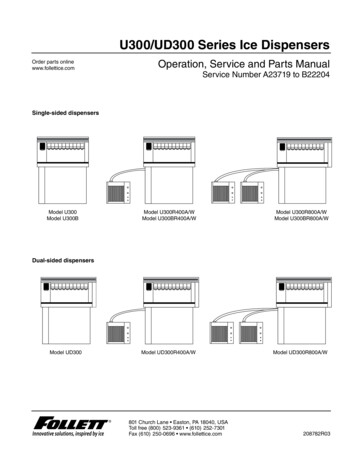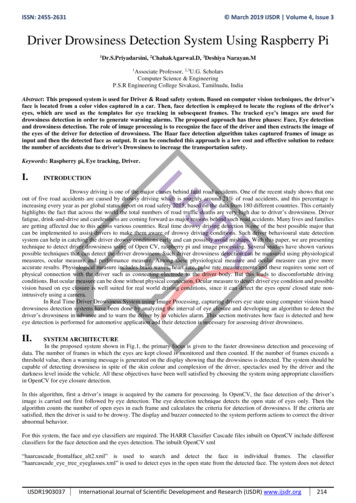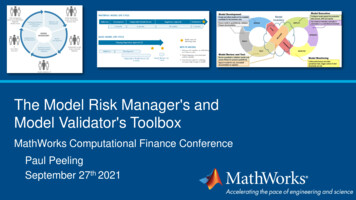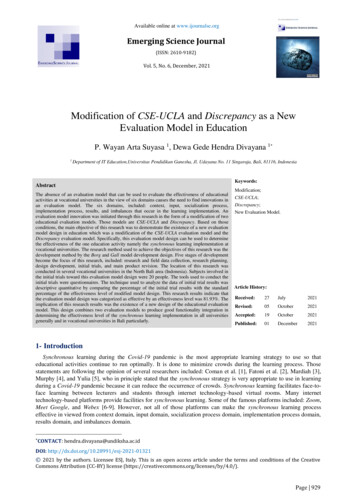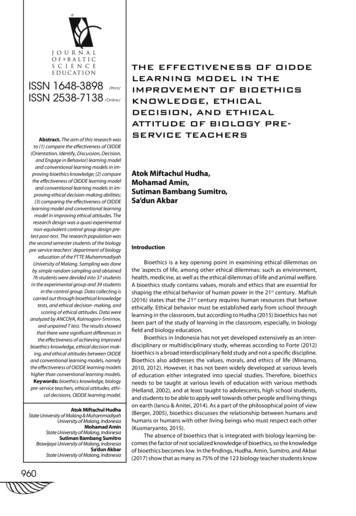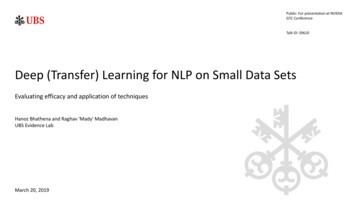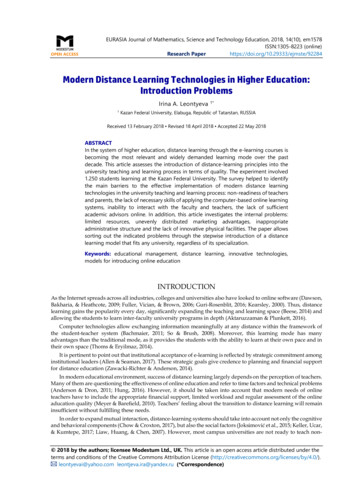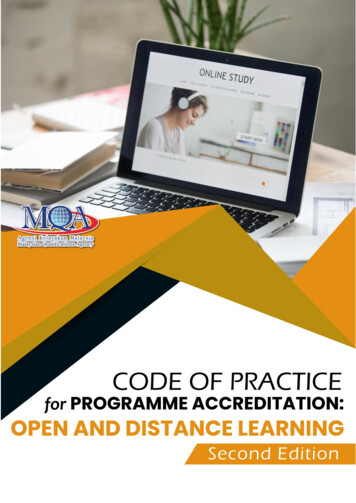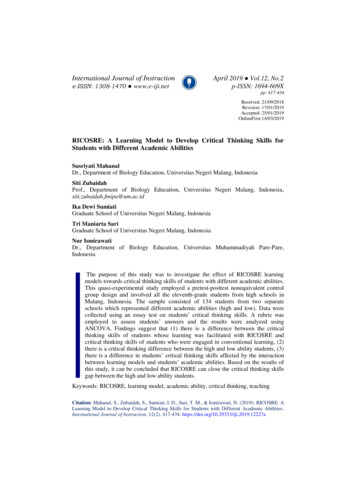
Transcription
International Journal of Instructione-ISSN: 1308-1470 www.e-iji.netApril 2019 Vol.12, No.2p-ISSN: 1694-609Xpp. 417-434Received: 21/09/2018Revision: 17/01/2019Accepted: 25/01/2019OnlineFirst:14/03/2019RICOSRE: A Learning Model to Develop Critical Thinking Skills forStudents with Different Academic AbilitiesSusriyati MahanalDr., Department of Biology Education, Universitas Negeri Malang, IndonesiaSiti ZubaidahProf., Department of Biology Education, Universitas Negeri Malang, Indonesia,siti.zubaidah.fmipa@um.ac.idIka Dewi SumiatiGraduate School of Universitas Negeri Malang, IndonesiaTri Maniarta SariGraduate School of Universitas Negeri Malang, IndonesiaNur IsmirawatiDr., Department of Biology Education, Universitas Muhammadiyah Pare-Pare,IndonesiaThe purpose of this study was to investigate the effect of RICOSRE learningmodels towards critical thinking skills of students with different academic abilities.This quasi-experimental study employed a pretest-posttest nonequivalent controlgroup design and involved all the eleventh-grade students from high schools inMalang, Indonesia. The sample consisted of 134 students from two separateschools which represented different academic abilities (high and low). Data werecollected using an essay test on students’ critical thinking skills. A rubric wasemployed to assess students’ answers and the results were analyzed usingANCOVA. Findings suggest that (1) there is a difference between the criticalthinking skills of students whose learning was facilitated with RICOSRE andcritical thinking skills of students who were engaged in conventional learning, (2)there is a critical thinking difference between the high and low ability students, (3)there is a difference in students’ critical thinking skills affected by the interactionbetween learning models and students’ academic abilities. Based on the results ofthis study, it can be concluded that RICOSRE can close the critical thinking skillsgap between the high and low ability students.Keywords: RICOSRE, learning model, academic ability, critical thinking, teachingCitation: Mahanal, S., Zubaidah, S., Sumiati, I. D., Sari, T. M., & Ismirawati, N. (2019). RICOSRE: ALearning Model to Develop Critical Thinking Skills for Students with Different Academic Abilities.International Journal of Instruction, 12(2), 417-434. https://doi.org/10.29333/iji.2019.12227a
418RICOSRE: A Learning Model to Develop Critical Thinking INTRODUCTIONHigh-quality education equips students with higher order thinking skills (Zubaidah,Fuad, Mahanal, & Suarsini, 2017) that allow students to develop an ability to produceideas and to solve problems in learning (Heong, Yunos, Othman, Hassan, Kiong, &Mohamad, 2012). These skills are usually embedded in a particular discipline, such asbiology. One of the components of the higher order thinking is critical thinking skills(King, Goodson, & Rohani, 2010).Critical thinking skills include analyzing, evaluating, and reconstructing information inorder to make a decision and act on it (Haghparast, Nasaruddin, & Abdullah, 2013). Theskills, needless to say, can help students to deal with social problems, scientificproblems, and practical problems effectively. Therefore, these skills can be integratedinto a learning process through exercises and simulation (Colln-Appling & Giuliano,2017).Critical thinking skills play a major role in students’ success in learning (Halpern,Millis, Graesser, & Butler, 2012); however, research conducted within an Indonesianlearning context showed students’ insufficiency in mastering the skills (Kurniawati,Zubaidah, & Mahanal, 2015). Also, as a result of the implementation of incompatibleand discouraging learning models, facts also prove that critical thinking skills of highschool students in Malang, especially in Biology, fall into the low category (Corebima,2016).Academic ability is one of the determining factors of students’ achievement in masteringcritical thinking skills. Students with good academic ability will be more competent toconstruct ideas and solve problems logically (Karbalaei,2012). Academic ability isassociated with intelligence effects and intelligence is an important element in thedevelopment of students' critical thinking (Karagol & Bekmezci, 2015).High School student admission system in Indonesia is one of the reasons why there wasan achievement gap between the high ability and low ability students. The admissionsystem requires schools to use the Minimum Passing Level National Exam (MPLNE)scores as the standard to select their students which leads to a phenomenon where someparticular schools are dominated by either the high or low ability students only. Forexample, Public High School Number 3 in Kupang, only want students who had a scoreof MPLNE between 27.70-36.04, while PGRI High School in Kupang can acceptstudents with scores of MPLNE between 11.00-12.00 (Yusnaeni, Corebima, Susilo, &Zubaidah, 2017).There has been a paradigm shift in scientific subjects learning. Some learning modelshave been enhanced to accommodate the development of students’ higher-order thinkingskills (Leou, Abder, Riordan, & Zoller, 2006), placing the teacher as the agent who isresponsible to encourage students to think at the higher order levels. Yet, the facts showthat science subjects learning is mostly focused on information transfer rather thanempowering activities that can develop students’ scientific reasoning (Mainali, 2012).International Journal of Instruction, April 2019 Vol.12, No.2
Mahanal, Zubaidah, Sumiati, Sari & Ismirawati419One way to promote students’ critical thinking skills is through training. During thetraining, students should be taught how to create meaningful links among concepts in aproportional form and how to find a relationship between knowledge and practice(Novak & Canas, 2006). These activities can be accommodated by a learning model(Cantor, DeLauer, Martin, & Rogan, 2015).Critical thinking skills can be taught explicitly. Teachers can implement a studentcentered learning model to help students develop the skills (Mahanal, Zubaidah, Bahri,& Dinnuriya, 2016; Fuad, Zubaidah, Mahanal, dan Suarsini, 2017). One of the examplesof the student-centered learning models is a learning model called RICOSRE (Reading,Identifying a problem, COnstructing the solution, Solving the problem, Reviewing thesolution, and Extending the solution).The main focus of RICOSRE is problem solving activities (Mahanal & Zubaidah,2017). As pointed out by Hussain & Munshi (2011), problem-based learning emphasizesthe enhancement of students’ critical thinking skills rather than knowledge acquisition.An effective way to teach problem-solving strategies to students is to guide them toapply a series of problem-solving activities in details (Moreno, Reisslein, & Ozogul.2009). As students develop problem-solving skills, their higher order thinking skills canalso be promoted (Carson, 2007; Kumar & Natarajan, 2007; Snyder &Snyder, 2008).Therefore, problem-based learning is considered more promising in developingstudents’ critical thinking skills compared to conventional learning which is merelyfocused on content memorization (Bachtiar, Zubaidah, Corebima, & Indriwati, 2018).RICOSRE learning model is designed to improve students’ higher-order thinking. Thesyntax of RICOSRE consists of reading, identifying a problem, constructing thesolution, solving the problem, reviewing the solution, and extending the solution(Mahanal & Zubaidah, 2017). RICOSRE learning model has been proven effective toenhance students’ critical thinking skills (Sumiati, 2017), creative thinking skills (Sari,2017), science literacy (Rosyada, 2018), science process skills (Yuliskurniawati, 2018),and scientific argumentation skills (Noviyanti, 2018); however, RICOSRE potential toclose the gap between the low and high ability students’ needs to be explored.Theoretical BackgroundCritical Thinking SkillsNumerous definitions of critical thinking show plenty of dimensions. Dewey equalizescritical thinking in reflective thinking and states that building reflective thinking is thecore of education (Giancarlo & Facione, 2001). Critical thinking is also interpreted asactivating the ability to analyze and evaluate evidence, identify questions, and constructlogical conclusions. Critical thinking skills result from an intellectual process to apply,analyze, synthesize and evaluate information collected from or by active and creativeobservation, experiences, reflection, reasoning, and communication (Facione, 2013).The common definition of critical thinking is conveyed by Ennis (2013) who elucidatesit as a reasonable reflective activity that focuses on deciding what to believe and what todo. Critical thinking involves the activities of interpreting, analyzing, summarizing, andevaluating information. Accuracy, precision, relevance, depth, wideness, logic,International Journal of Instruction, April 2019 Vol.12, No.2
420RICOSRE: A Learning Model to Develop Critical Thinking significance, and fairness are critical thinking merits. Think critically is to focus onanalyzing, organizing, clarifying, developing, prioritizing, or sorting out ideas(Treffinger & Isaksen, 2013). Critical thinking can help students make careful judgmentand resolve problems on a daily basis (Zubaidah, Corebima, Mahanal, & Mistianah,2018).Critical thinking skills are crucial for students because they take part in students’thinking development. Critical thinking skills belong to one of the basic and intellectualneeds every individual has to meet (Aizikovitsh-Udi & Cheng, 2015). Critical thinkingis not only able to enhance students’ academic ability but also can prepare students tobecome a professional in the work field.RICOSRE Learning ModelRICOSRE is a problem-based learning model developed by Mahanal & Zubaidah(2017). RICOSRE is an acronym of syntax consisting of (1) Reading (2) Identifying theproblem, (3) Constructing the solution, (4) Solving the problem (5) Reviewing thesolution and (6) Extending the solution. Every stage of RICOSRE facilitates students toapply higher order thinking as explained below.The first syntax is reading. Reading is not only about expressing what is in the text butincludes the process of constructing meaning (Akin, Koray, & Tavukcu, 2015; Yu-hui,Li-rong, Yue, 2010). Reading also involves coordinating affective and cognitivecomponents such as observing, focusing, having perception, memorizing, buildingrelationships, analyzing, and interpreting (Çer & Şahin, 2016).The second syntax is identifying a problem. This stage constitutes the foundation of theproblem solving process (Hippel & Krogh, 2015). At this stage, the problem solver, inthis case, the students are required to identify an unclear and unstructured problem. Theidentified problem will then be formulated into questions to be solved. Formulatingquestions and asking questions are the indicators of critical thinking skills (Ennis, 2011).The third syntax is constructing the solution. This phase allows students to find one ormore strategies to solve the problem. Every strategy must include detailed procedures onhow to solve the problem (Cheng, She, & Huang, 2018). Students who think criticallyadmit that the critical thinking activity is an effort to provide responses to the inquiriesor to construct solutions to the problem.The fourth syntax is solving the problem by implementing the problem-solvingprocedures introduced at the previous stage. The problem solving strategy representsone’s thinking skill (Temel, 2014). The fifth syntax is reviewing the solution wherestudents will communicate to get feedback and to widen the information from theinvestigation results. The sixth syntax is extending the solution where students analyzehow effective and efficient the strategy and analyze the probability to apply the solutionto similar problems (Bayazith, 2013). Extending the solution is done by encouragingstudents to apply new knowledge and skills obtained from solving the problem to a newhomogeneous phenomenon. Understanding the nature of the problem and developingskills to solve it are amount to critical thinking skills (Paul & Elder, 2007).International Journal of Instruction, April 2019 Vol.12, No.2
421Mahanal, Zubaidah, Sumiati, Sari & IsmirawatiAcademic abilityThe academic ability can be defined as an achievement in knowledge and skills learnedin an academic context (Kızılhan, 2011). Initial academic ability is students’ knowledgethat covers mastering specific contents they have learned prior to participating in a newlesson chapter (Torff, 2006). As the basis of the knowledge construction process, thisknowledge helps students to integrate new knowledge (Felton & Kuhn, 2007). Theinitial academic ability can have a significant effect on students’ upcoming academicability, which means that the knowledge may become a strong predictor on how wellstudents will achieve the learning objectives (Hattie, 2012). In addition, students’ priorknowledge has been proven to significantly contribute to students’ academic ability(Yenilmez, Sungur, & Tekkaya, 2006).Academic ability is associated with critical thinking skills (Dehghani, Mirdoraghi, &Pakmehr, 2011). Students who possess high academic ability are better at processinginformation, organizing, deducting, and exploring knowledge based on experiences(King, Goodson, & Rohani, 2010). The relationship between academic ability andcritical thinking skills has been shown in the previous studies. The results of the studiesshow that critical thinking skills of students who have the high academic ability aresuperior to those of students with the low academic ability (Mamu, 2014; Taghva,Rezai, Ghaderi, & Taghva, 2014).Research ObjectivesThe current research aimed to identify (1) the difference between critical thinking skillsof students whose learning was facilitated with RICOSRE and critical thinking skills ofstudents who were taught with conventional learning methods, (2) the differencebetween high ability students’ critical thinking skills and low ability students’ criticalthinking skills, (3) the difference in students’ critical thinking skills affected by theinteraction between learning models and students’ academic abilities.METHODModel of ResearchThis quasi-experimental study employed a pretest-post-test nonequivalent control groupdesign using factorial 2 x 2 version as shown in Table 1. The independent variables ofthis research included learning models (RICOSRE and conventional) and academicability (AA) while the dependent variable of this study was the students’ critical thinkingskills.Table 1Quasi-Experimental Research tO2O4O6O8Notes:O1.3.5.7 pretestO2.4.6 post-testInternational Journal of Instruction, April 2019 Vol.12, No.2
422RICOSRE: A Learning Model to Develop Critical Thinking X1 RICOSRE learning modelX2 conventional learning modelY1 high academic abilityY2 low academic abilityResearch SettingThis research was conducted from August to December 2017 in high schools in Malang,Indonesia. It was carried out on two lesson topics, the Structure and Function of PlantTissue, and the Structure and Function of Animal Tissue.Research Population and SampleThe population of this research was all the eleventh grader from 10 (ten) high schools inMalang, Indonesia which consisted of three public high schools representing the highability group, four public high schools representing the medium ability group, and threepublic high schools representing the low ability group. The selection of the school’scategory was done based on the Passing Level National Exam scores set by theDepartment of Education Malang, Indonesia. Multi-stage sampling technique was usedto select the samples from two groups of students, the high ability (1 school) and the lowability (1 school). The high category was represented by 68 students from two classes ofPublic High School Number 4 in Malang and the low category was represented by 68students from two classes of Public High School Number 10 in Malang. The totalnumber of research participants was 136 students who were divided into twoexperimental classes and two control classes.The experimental classes were taught by the researchers using RICOSRE, while thecontrol classes were taught by the school’s Biology teachers using conventionalmethods. Students in the RICOSRE classes were equipped with the worksheet. Theworksheet contained two learning activities. Learning activity 1 discussed the structureand function of each of the plant tissues, while learning activity 2 discussed the structureand function of each of the animal tissues. The learning stages contained in theworksheet were adjusted to the RICOSRE learning syntax. There were texts provided onthe worksheet. The students were required to read the texts before proceeding to thenext stage of learning that was to identify a problem. After identifying the problem, thestudents needed to formulate it in the form of questions and predict the answer. Then,the students were required to construct a solution to the problem, choose an appropriatestrategy to solve the problem by making hypotheses, simplify the problem, and makeassumptions based on knowledge obtained from the previous stage. After that, thestudents had to implement the problem solving strategy and write the results on theworksheet. The results of the collaborative work were then communicated with othergroups. Feedback and suggestions were welcomed at this stage. The last stage ofRICOSRE was to allow the students to evaluate the effectiveness of the problem solvingstrategy and to probably find an alternative solution which is more effective than theprevious or to make problem generalization which can help them to solve similarproblems in the future. In RICOSRE, the students played a more significant role inlearning compared to the teacher. The teacher, in this case, served as an active facilitatorInternational Journal of Instruction, April 2019 Vol.12, No.2
423Mahanal, Zubaidah, Sumiati, Sari & Ismirawatiin the classroom. S/he had to guide or provide scaffolding for the students whennecessary. Unlike RICOSRE, the conventional methods did not follow certain learningsyntax. On the other hand, conventional methods mainly included information transfer(lecturing), group discussion, and task assignment. The implementation of RICOSREand conventional methods in this study used the same duration and the same basiccompetencies.Instrument and Data AnalysisThe student’s critical thinking skills were measured using the essay test. The essay testwas selected as the instrument because it was considered the most suitable test to beapplied in Indonesia (Zubaidah, Corebima, & Mistianah, 2015). The question contained8 essays included the topics of the structures and functions of the plant and animaltissues. Here are two examples of the essay test items.1. Gresik city has low air humidity and deep groundwater sources. The governmentplans to build some green spaces with an “evergreen” concept and plant pinetrees in the areas. Make a logical statement about the effectiveness of theevergreen pine-green spaces!2. Liposuction is a surgical technique wherein the doctor draws a certain amount offat from several parts of the patient's body. This technique is useful forremoving fat deposits in certain parts that are stored in the form of fat drops ordroplets. The body weight of people who have undergone liposuction tends torise quickly because new fat cells will be placed on other parts of the body.Based on the statement, analyze the relationship between the impact ofliposuction and the body's tissue structure!The students’ answers were evaluated using a rubric developed by Zubaidah et al.(2015). This rubric measured two categories: student’s critical thinking which is notapparent or not well developed (score 1-2) and starts to developed or well developed (35). The instrument test had been validated and satisfied the standard of a reliable test.The validity test was performed using the product moment correlation with sig level0.0001-0.013 a (a 0.05). Cronbach's Alpha statistics showed that instruments werereliable with r 0.689. The validity and reliability can be seen in Table 2.Table 2The Results of the Validity and Reliability TestsNumber12345678Pearson 4Sig. tional Journal of Instruction, April 2019 Vol.12, No.2
424RICOSRE: A Learning Model to Develop Critical Thinking Data Collection and Data AnalysisThe research data were analyzed using covariance analysis (ANCOVA), normality test,and sample homogeneity test. These data were collected to test the hypotheses whichwere formulated as follows: (1) There was a difference in students’ critical thinkingskills after receiving different treatments of learning models (2) There was a differencein students’ critical thinking skills in regards to different academic abilities (3) Therewas a difference in students’ critical thinking skills in regards to the interaction betweenlearning model and academic abilities.The analysis of covariance (ANCOVA) was begun by performing a normality test usingOne-Sample Kolmogorov-Smirnov Test. The homogeneity test used the Leven’s Test ofEquality of Error Variances. The normality test conducted on the students’ criticalthinking skills resulted in p-value 0.200, p-value α (α 0.05) which suggested that thedata was distributed normally. The result of the homogeneity test showed p-value 0.872,p-value α (α 0.05) which implied that the students’ critical thinking skills werehomogeneous.FINDINGSThe results of the ANCOVA analysis were presented in Table 3 and Table 4. The resultof the ANCOVA test alone was summarized in Table 3. Table 3 indicated that H0 shallbe rejected and hence the alternative hypothesis which suggested that there was adifference in students’ critical thinking skills after they were exposed to two differentlearning models was accepted with F(x1,x2) 23.448 and a significance level of 0.00 0.05). In addition, with F(x1,x2) 24.727 and a significance level of 0.00 0.05, thetable implied that there was a difference between high ability students’ critical thinkingskills and low ability students’ critical thinking skills. In other words, H0 was rejectedand H1 was accepted. The table also showed that there was a difference in students’thinking skills as the result of the interaction between the learning models and academicabilities with F(x1,x2) 6.937, sig. 0.002 0.005).Table 3The Results of the ANCOVA AnalysisSourceType III Sum of SquaresDfMean Pre-CriticalAAModelAA * tal Score18225.765135Note:Pre-Critical: pretest of critical thinking skillsAA Academic AbilityInternational Journal of Instruction, April 2019 Vol.12, No.2
425Mahanal, Zubaidah, Sumiati, Sari & IsmirawatiBased on the results, the Least Significance Difference (LSD) test could be conducted.Findings of the test were depicted in Table 4. Table 4 suggested that there was a clearcut difference between the combined groups. The RICOSRE-AA low group result wasdifferent from that of the Conventional-AA low group. However, the RICOSRE-AAhigh and the RICOSRE-AA low group did not show any significant difference, neitherdid the conventional-AA high group and RICOSRE-AA low group. The ConventionalAA high group was reported to be significantly different from the Conventional-AA lowgroup. Given the information presented in Table 3, the Conventional-AA low groupachieved the lowest total score (66.41) while the highest score (87.36) was obtained bythe RICOSRE-AA high group. The Conventional-AA high group was reported toachieve better (80.41) than the RICOSRE-AA low (78.86). The highest score increase(from the pretest to posttest) was observed in the RICOSRE-AA high group (14.76 or20.06%), followed by the RICOSRE-AA low group (11.68 or 17.11%), theConventional-AA high group (9.85 or 13.99%), and the Conventional-AA low group(5.52 or 0.8%). The results suggested that RICOSRE learning model was able toimprove the low ability students’ critical thinking skills to the point equal to what thehigh ability can attain in the conventional group.Table 4The Result of the Least Significance Difference (LSD) :AA Academic AbilityIn summary, according to Table 3 and Table 4, it can be concluded that: (1) The nullhypothesis that stated learning models had no effect on students’ critical thinking skillswas rejected and hence the research hypothesis was accepted because the results of thisstudy suggested that learning models had an effect on the students’ critical thinkingskills (Shim & Walczak, 2012); (2) The null hypothesis that stated that there was nodifference found between the high and low ability students’ critical thinking wasrejected and hence the research hypothesis was accepted. There are no errors in thishypothesis because the results of the study are in accordance with the theory whichsuggests that academic abilities influence students' critical thinking skills. Students withhigh academic abilities have better initial knowledge than students with low academicabilities. Therefore, the thinking skills of the high ability students can improve moresignificantly faster than those of the low ability students (Ausubel, 1998). (3) The nullhypothesis which stated that there was no interaction effect of the learning model withstudents’ academic ability shall be rejected and hence the research hypothesis shall beaccepted. No consistent results were found in the interaction between learning modelsInternational Journal of Instruction, April 2019 Vol.12, No.2
426RICOSRE: A Learning Model to Develop Critical Thinking and academic abilities and its impact on students’ higher-order thinking such as criticaland creative thinking.DISCUSSIONLearning Models and Students’ Critical Thinking SkillsThe results of the current research have proven that there is a difference found in thestudents’ critical thinking skills after their learning was accommodated by RICOSRE.Compared to the students who used conventional learning, the RICOSRE group ofstudents was reported to score significantly better at the critical thinking skills test.There are many studies that mention the benefits of implementing RICOSRE inpromoting students’ critical thinking skills. One of which is that RICOSRE learningmodel facilitates students’ active involvement in the learning process (Mahanal, et al.2017). By applying the learning model, students are encouraged to think actively(Mulnix, 2012) and as a result, be passionately engaged in discussion and evaluationactivities. The students’ active participation in learning may result in their increasedability to make decisions, predict assessment, and solve problems (Burbach, Matkin, &Fritz, 2004).The contribution of RICOSRE learning model lays on its syntax which consists ofreading, identifying a problem, constructing the solution, solving the problem, reviewingthe solution, and extending the solution. Improving students' critical thinking skills issupported by an increase in reading activities. Reading has a strategic position inempowering students' thinking skills (Zubaidah, 2014). Reading activities are directlyconnected with critical activities because reading often requires critical, analytical, andexpressive abilities, as well as self-discovery (Wang, 2012). Furthermore, according toAljaberi (2015) understanding problems can lead students to the process of criticalthinking. This stage contains activities to identify available information and data,assumptions, and expected results. Making questions and predicting answers alsocontribute to improving students' critical thinking skills. Critical students will makecritical questions. Questions are a tool that can be used to improve students' thinkingskills (Lubliner, 2004). In the next stage, that is to construct the solution, students canaccess, analyze, and synthesize relevant information to explore the problem.Constructing a solution is seen as a cognitive process that has implications for students’literacy development in higher order thinking (Naderi, et al., 2010).Problem solving activities can be used by teachers to teach students how to think.Students' thinking skills can be developed through problem-based learning and theimprovement of students’ critical thinking skills, creative thinking skills, decisionsmaking ability, conceptions formation, and information processing (Carson, 2007). Thefinal stage in the face-to-face learning was reviewing and extending the solution. At thisstage, the students were guided to conduct class discussions and reflect on suggestionsgiven by other students from other groups. Also, the students were required to have theability to choose the right concepts to be accepted as suggestions. These skills provide agood impact on students' critical thinking skills (Hussain & Munshi, 2011).Academic Abilities and Students’ Critical Thinking SkillsInternational Journal of Instruction, April 2019 Vol.12, No.2
Mahanal, Zubaidah, Sumiati, Sari & Ismirawati427The results of the hypothesis testing presented in Table 2 show that there is a differencebetween high ability students’ critical thinking skills and low ability students’ criticalthinking skills. Some studies have underlined the effect of different academic abilitieson students’ critical thinking skills (Taghva et al., 2014; Mahanal, Tendrita, Ramadhan,Ismira
An effective way to teach problem-solving strategies to students is to guide them to apply a series of problem-solving activities in details (Moreno, Reisslein, & Ozogul. 2009). As students develop problem-solving skills, their higher order thinking skills can also be promoted (Carson, 2007; Kumar & Natarajan, 2007; Snyder &Snyder, 2008).

